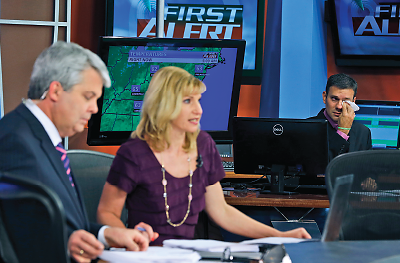The shooting deaths of two Virginia television journalists on August 26 went out over the air during a live broadcast, exposing viewers to real-life violence and trauma as it happened, and once again raising the purported connection between mental illness and violence.
WDBJ reporter Alison Parker and cameraman Adam Ward were interviewing economic development official Vicki Gardner in Smith Mountain Lake, Va., when a gunman identified as Vester Lee Flanagan attacked them. Parker and Ward were killed, and Gardner was injured.
Flanagan, who was fired from the station two years ago, uploaded his own video of the murders on social media and later killed himself after a police chase.
As family members, friends, and coworkers of the victims grieved over the two young people, viewers, especially children, also may have been traumatized by what they saw on live television. Each person affected needed to be approached individually if support was needed, said APA President Renée Binder, M.D., a professor of psychiatry at the University of California, San Francisco, in an interview.
“It is normal to have a reaction, such as anxiety or intrusive thoughts,” said Binder. “People don’t have to talk about it, but there should be no stigma in doing so if they wish.”
In any work setting, an employee who seems unduly upset or threatening should be taken seriously by fellow workers, said Binder. At her home institution, a multidisciplinary team drawing on university police, legal experts, psychiatrists, human resources, faculty affairs, and the dean of students office collectively evaluates all available information when such cases arise.
“It’s better to do this as a group,” she said. “It’s hard for an individual to decide alone what to do.”
In any organization, employee assistance programs may also be a source of help for an employee who is under stress or is reacting to some tragedy, she said.
The Virginia incident was especially troubling for other workers in the news media. Journalists face danger covering wars, disasters, and crime that can affect their own mental health, but the incident in Virginia touched a special nerve.
“Many news professionals I know were deeply rattled by this terrible event,” said Bruce Shapiro, executive director of the Dart Center for Journalism and Trauma, a project of the Columbia University Graduate School of Journalism. The center trains journalists to prepare for and cope with reporting on violence, conflict, and tragedy.
“For one thing, our workplace is wherever we open our notebook or take out a microphone or plant a camera, and this reminded us of just how vulnerable that makes us to work-inspired violence, whether from a disturbed former colleague or a stranger,” said Shapiro in an interview. “At the same time, many journalists reacted with sympathy and solidarity with our colleagues in Virginia. Locally in Roanoke, the main competitor station to the victims’ employer even offered to cover the day’s events for the grieving staff.”
The killer was described as “troubled,” and court documents in an employment-related lawsuit delineated a history of behavioral problems while he worked at the station.
“Most mental illness is treatable if you get to the sufferer . . . in this case we did not,” WDBJ’s General Manager Jeff Marks said at a memorial service for the two newspeople in Roanoke on August 30.
However, the rush, once again, to associate violence with mental illness concerned some psychiatrists.
People with mental illness are more often victims of crimes than perpetrators.
“When people with mental illness commit gun violence, they usually kill themselves more often than they kill anybody else,” forensic psychiatrist Liza Gold, M.D., told Psychiatric News.
“Mental illness is not the most significant risk factor in whether people become violent and commit these acts,” said Gold, who is in private practice in Arlington, Va., and is a clinical professor of psychiatry at Georgetown University School of Medicine. “Too many people automatically assume that if someone is angry, violent, and dangerous, then they must be mentally ill. That is the nature of the negative stereotyping of people with mental illness in our society and it’s just not accurate.” ■
The American Psychiatric Association Foundation’s
Partnership for Workplace Mental Health has more information on employer-employee mental health. The Dart Center’s “Trauma in the Newsroom: Tips for Managers” can be accessed
here.


